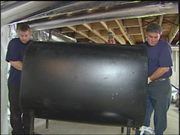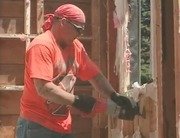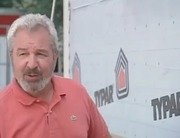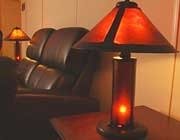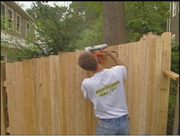I'm Bob Vila.
Welcome to the show where our basement refinishing project is coming along nicely.
And today we're spending a fair amount of our time, doing rough HVAC type of stuff.
We are getting the boil tank wrapped and doing some changes to it, but we're also installing a brand new heating, ventilating and air conditioning system.
And we'll give you some tips on how to get rid of squeaky floors, as well as sealing the concrete slab.
Don't go away.
Remodeling a basement space to create play room or what ever in an old house usually means you're going to have a lot of old pipes and duct work to deal with.
And last week we showed you a little bit about what we had to do here in terms of removing some of that piping and rerouting others.
And actually, bringing in new piping.
Because we've got a perimeter system to control any kind of water infiltration in from under, underground and that's part of it right here.
But anyway, this week we're talking about what you need to do in terms of heating, ventilating and air conditioning, HVAC.
And we've already got most of the work done, thanks to our friends at Trane, and at Total Temperature Control here in Wakefield.
And last week John Ambrosino took us through the steps of installing all this equipment and helping us understand what it's going to do for us.
Watch.
Hi, I'd like to explain.
Our biggest twist is we took the system we had, and laid it horizontal.
We measured from the floor to ceiling, we had 82 inches.
And we needed 124.
So, we had to get a little creative.
And we got a horizontal versus a vertical mount.
Now, this allows us to attach the system to your roof rafters using threaded rod and finish that with armor flex covering it to give it some vibration elimination.
We also use flux connections in both the supply and as we tie in, the return duct, which Matt is cutting out right now.
Now what happens by leaving it so it can move over a bit it allows any transmission to be eliminated so the home owner cannot hear any transmission.
Matty right now is cutting open the supply.
This is where it all begins.
Basically, what we do is take the unconditioned air from your home.
Run it through the return duct, which is going to be attached to the opening over there and it runs through your system.
And the first thing we're going to do is we're going to filter.
What we do is we use a Trane CleanEffects filter and what this thing does, is take out 98.
98% of all particulates in the air.
So all pollutants would be removed from the air, prior to getting conditioned.
First thing we do, is we go through our fan system.
A fan system is a variable drive system.
this allows the home owner to experience tremendous comfort, as well as save up to $500 a year with energy savings.
What we do is we program this fan to operate based on the duct work installed in the home owner's home.
So we design each house differently.
As the air passes through this fan, it goes through.
And if it's in heating mode our Beckett oil-fired furnace heats the heat exchanger, and indirectly heats the air going across it.
Passes through the dormant air conditioning coil during the heating side and goes out and gets distributed to the duct work throughout the home.
Now, what happens if it's in cooling, is, we do the same system.
We come to the variable speed fan at a different speed, a much higher speed, to allow, to carry the air conditioning air we go to a now dormant heating system.
Go through our refrigerant coil, get conditioned, dehumidified, and pass through the rest of the home.
And what's interesting about this coil is, that again, as you can see a larger pipe
Is this suction line, that is where we turns back to the systems and this is the liquid line, this is the high pressure liquid that comes into our system, goes into a pipe which is connected to expansion valve, which I will show in a moment, it gets blast of to a cooler low pressure gas, and goes back to the system.
As you can come over here, I can show you this is the expansion valve, the
high pressure liquid enters the expansion valve, gets flashed off, goes through the distributor tube, and ends up filling the coil up with refrigerant, which absorbs all the heat and humidity in the air, so it can be conditioned well for the home.
Once it goes through here, felt the side it's conditioned and goes into the home
This is where our pipes originate from.
Here's our suction line again and here's our liquid line.
This is our concrete pad.
What we did is poor a four inch concrete pad to accept our condensing unit.
Which the man is bringing in, as we speak right now.
As you can tell, it's a big unit.
It's a sixteen.
SEER system.
To allow the homeowner to get the most benefit, and energy saving, cooling this coming season.
As you may have noticed, the system is very large.
It's a four ton system.
The reason it's so large is it's very efficient.
And that's it's SEER value.
It's SEER is 16.
Seasonal Energy Efficiency Ratios is the pronunciation for SEER.
The system is larger because it is able to dissipate more heat from the system at a rapid rate, to save energy.
This system can up to 45% off your energy cost by it's efficient operation and design.
The system is whisper quiet , has a fan that dissipates heat from basically inside and dissipates it outside.
It's a very quiet, a very efficient system.
OK.
So Mark Hagan's with us now to talk about indoor air quality right?
That's right, Bob.
And so the Trane filtration takes over at what point around here?
Well what we have installed here is the Trane
Need to fix, whole house filtration system.
Whether you have an older home , or a newer home that's tightly sealed, indoor air quality is really important.
It is.
So we want to filter out all the particles, the dust, the pollen, the pet dander or anything that's in the air, that might effect a home owner and their health.
Yeah.
In the home.
Let me show you a little bit about how it works.
Now, the air that's circulated throughout the house is returning back down here through this area, right?
Yes, this is a return air.
Okay.
And the air comes into the unit here, and we have a three stage system, where we clean the air, the first stage is this pre-filter.
It's a one inch filter that catches the really big stuff.
It's already caught a bunch of stuff.
Yeah, it's already grabbed the big stuff.
Now what's this made out of, this filter?
Well this is a plastic mesh filter, and to clean it, you can wash it, or vacuum it.
But it's long lasting.
It's long lasting and reusable.
You don't have to have a replacement filter.
Then there's a -
Then the next stage is A field charger that charges the small particles that pass through the air.
So is there like a low voltage charge in there, or how does that work?
Well we take low voltage power and convert it to a high voltage DC charge.
So we get a good strong charge of all the particles that pass through the air.
And what's the point of charging the particles?
Because what we have is a collection cell that's the opposite charge.
Oh sure.
So it attracts the charged particles and captures those in this collection cell.
Terrific.
And we can remove a very very high percentage of particles in the air.
OK.
This is washable or you can vacuum it.
So then you don't have to go out hunt for replacement filters.
So there's no cost associated.
That's a great benefit OK let me help you put them back together, because I want to turn this thing on.
Shouldn't we clean...nah, we're fine.
Now this whole aspect of the job is so important in terms of not just everybody, grown ups, but also kids growing up.
That's right.
And making sure that that everything is clean.
So, what happens in here?
We've got a variable speed oil-fired furnace and I'll go ahead and turn the system on.
With a variable speed system, you get the very high efficiency with the 16 SEER outdoor unit, as well as quiet operation.
The motor will...
I don't hear a thing.
Yeah.
That's really quiet.
The motor will ramp up and get to the speed and just air flowing exactly where it needs to be.
Excellent.
Well, thank you, Mark.
Thank you, Bob.
Here it comes now.
